There’s something incredibly comforting about a bowl that’s both hearty and full of rich, spicy flavor. This Slow Cooker Korean Beef Noodles Recipe hits that sweet spot—tender, melt-in-your-mouth beef combined with chewy udon noodles and a kick of gochujang. Trust me, once you try it, you’ll want to make it again and again.
Jump to:
Why You'll Love This Recipe
This isn’t just any slow cooker dish—it’s got that perfect balance of sweet, tangy, savory, and spicy that Korean flavors are famous for. I love how the beef becomes unbelievably tender after hours of slow cooking, soaking up all the goodness. It’s such a hands-off meal but feels like you put in the effort of a complex dinner.
- Deep, rich flavor: The combination of gochujang, soy, and rice vinegar builds layers of flavor that are both comforting and exciting.
- Effortless slow cooking: You just set it and forget it—perfect if your day’s crazy but you still want a nourishing, impressive dinner.
- Versatile beef options: Whether you find ox cheek, short ribs, or chuck roast, they all work wonderfully in this recipe.
- Quick noodle finish: Adding udon noodles at the end means they stay perfectly chewy and don’t turn mushy.
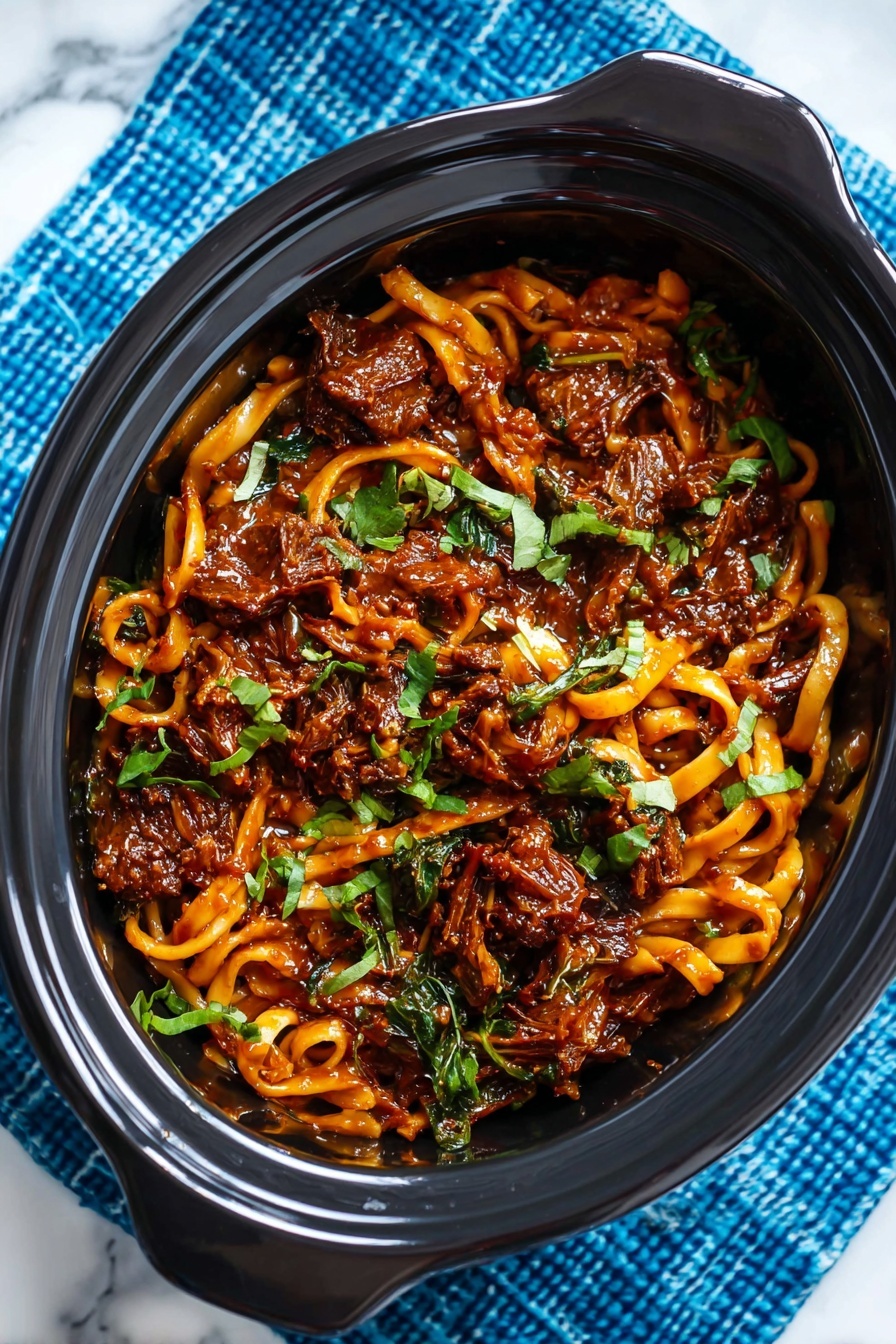
Ingredients & Why They Work
The ingredients blend harmoniously to create a sauce that’s rich but balanced, bold but not overpowering. Having the right balance between salty, sweet, tangy, and spicy is key; here’s why each one makes a difference.
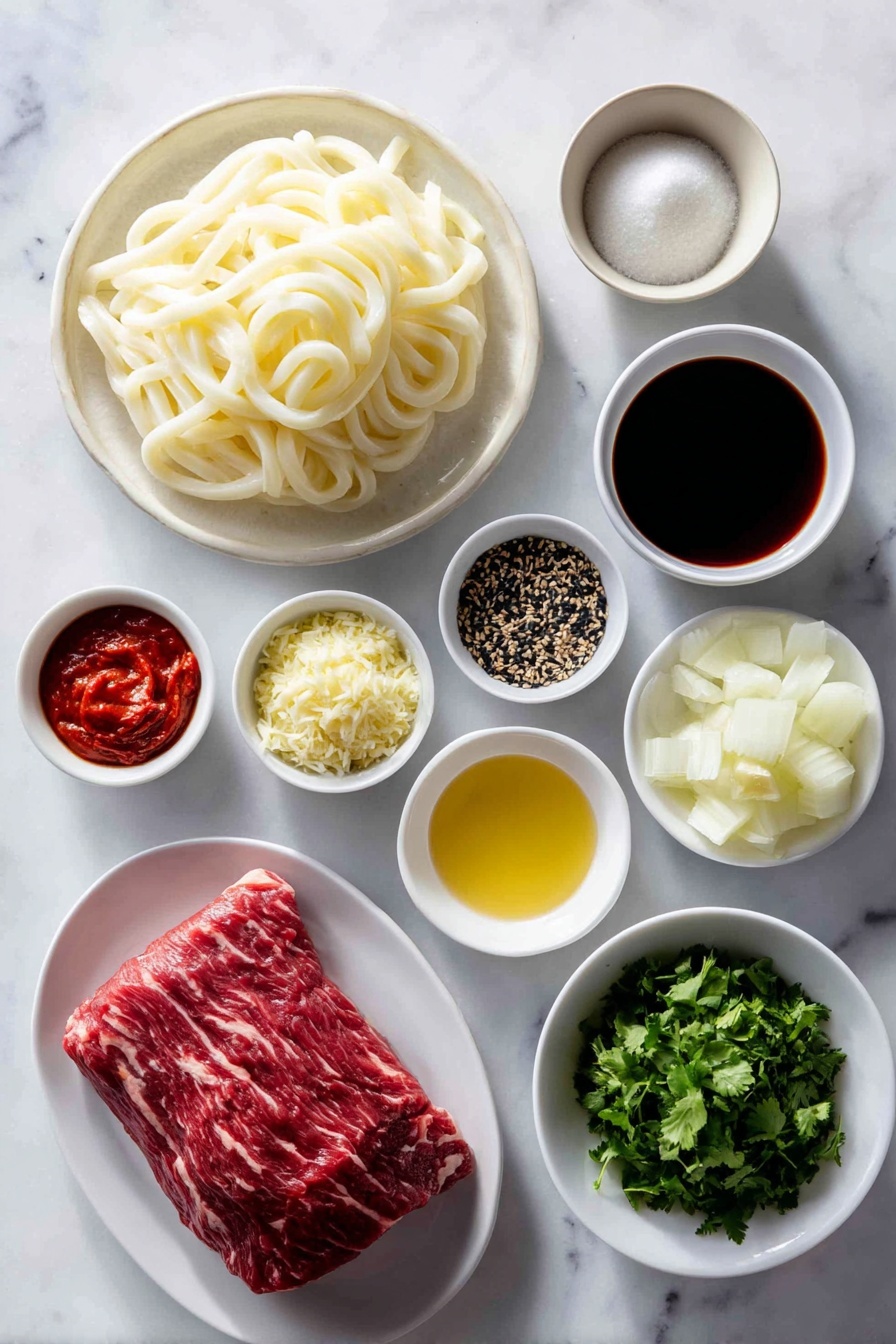
- Large onion: Adds natural sweetness and depth as it slowly cooks down.
- Gochujang: That spicy Korean chili paste is what gives this dish its signature heat and umami punch.
- Dark soy sauce: Brings salty richness and a slightly sweeter tone than regular soy sauce.
- Rice vinegar: Cuts through the richness with a subtle tang, keeping flavors bright.
- Light brown sugar: Balances spice and acidity with gentle sweetness.
- Garlic ginger paste: Provides aromatic warmth and a bit of pungency that wakes up the dish.
- Tomato paste: Enhances the umami and adds body to the sauce without overpowering other flavors.
- Low-sodium beef stock: Gives meaty, savory depth without making it too salty.
- Ox cheek (or substitutes): This cut shines slow-cooked until tender; alternatives like short ribs or chuck roast work well too.
- Ready-to-use udon noodles: Convenient and perfect for soaking up all that luscious sauce.
- Fresh coriander: Adds a fresh, herby burst to finish the dish.
- Black sesame seeds: For a nutty crunch and beautiful garnish.
- Kosher salt and freshly cracked black pepper: To season and balance flavors perfectly at the end.
Make It Your Way
One thing I really encourage is making this recipe your own. I usually tweak the spice level or swap the beef cuts depending on what I have on hand or how adventurous I’m feeling—don’t be shy about experimenting!
- Variation: Sometimes, I like to add a handful of sliced mushrooms or baby bok choy at the end for extra texture and veggies, which adds even more heartiness.
Step-by-Step: How I Make Slow Cooker Korean Beef Noodles Recipe
Step 1: Mix the Base Sauce
Start by adding the finely diced onion, gochujang, dark soy, rice vinegar, brown sugar, garlic-ginger paste, tomato paste, and beef stock to your slow cooker. Give it a good stir to combine everything well. This base sauce is where all the magic starts, so make sure to taste the mixture—adjust seasonings here if you want a bit more heat or tang.
Step 2: Add the Beef and Slow Cook
Place the ox cheek on top of the sauce, pressing it down lightly so all sides get coated. Pop the lid on and set your slow cooker to low for 8 hours. This long, slow simmer breaks down the collagen and fat, turning the beef fall-apart tender and deeply flavorful. I like to do this overnight or while I'm at work—then dinner’s basically ready when I get home.
Step 3: Shred and Return the Beef
Once the beef is cooked and super tender, shred it directly in the slow cooker using two forks. This step is so satisfying because you get to see how perfectly soft the meat is. Stir the shredded beef back into the sauce to soak up every drop of flavor.
Step 4: Add Noodles and Fresh Herbs
Now, add those ready-to-use udon noodles along with the chopped fresh coriander. Switch your slow cooker to high and cook for about 25 minutes more. This ensures the noodles become tender but don’t turn mushy, and the coriander keeps things bright and fresh.
Step 5: Final Season and Serve
Give it a taste and season with salt and pepper to your liking. Sprinkle the black sesame seeds on top for that gorgeous finish and a little crunch. This dish is best enjoyed hot, straight from the slow cooker to your bowl.
Top Tip
Through making this Slow Cooker Korean Beef Noodles Recipe a few times, I discovered a couple of small techniques that really elevate the dish and save you from common pitfalls.
- Use low-sodium stock: This lets you control the salt better, preventing the dish from becoming overly salty once the soy sauce is added.
- Don’t overcook the noodles: Adding them in the last 25 minutes avoids them getting gummy—just enough time to absorb the flavors.
- Shred within the slow cooker: It keeps everything tidy and lets the meat soak up juices instantly.
- Balance your spice: Depending on your gochujang brand, heat levels vary—start with less and add more after tasting the sauce base.
How to Serve Slow Cooker Korean Beef Noodles Recipe
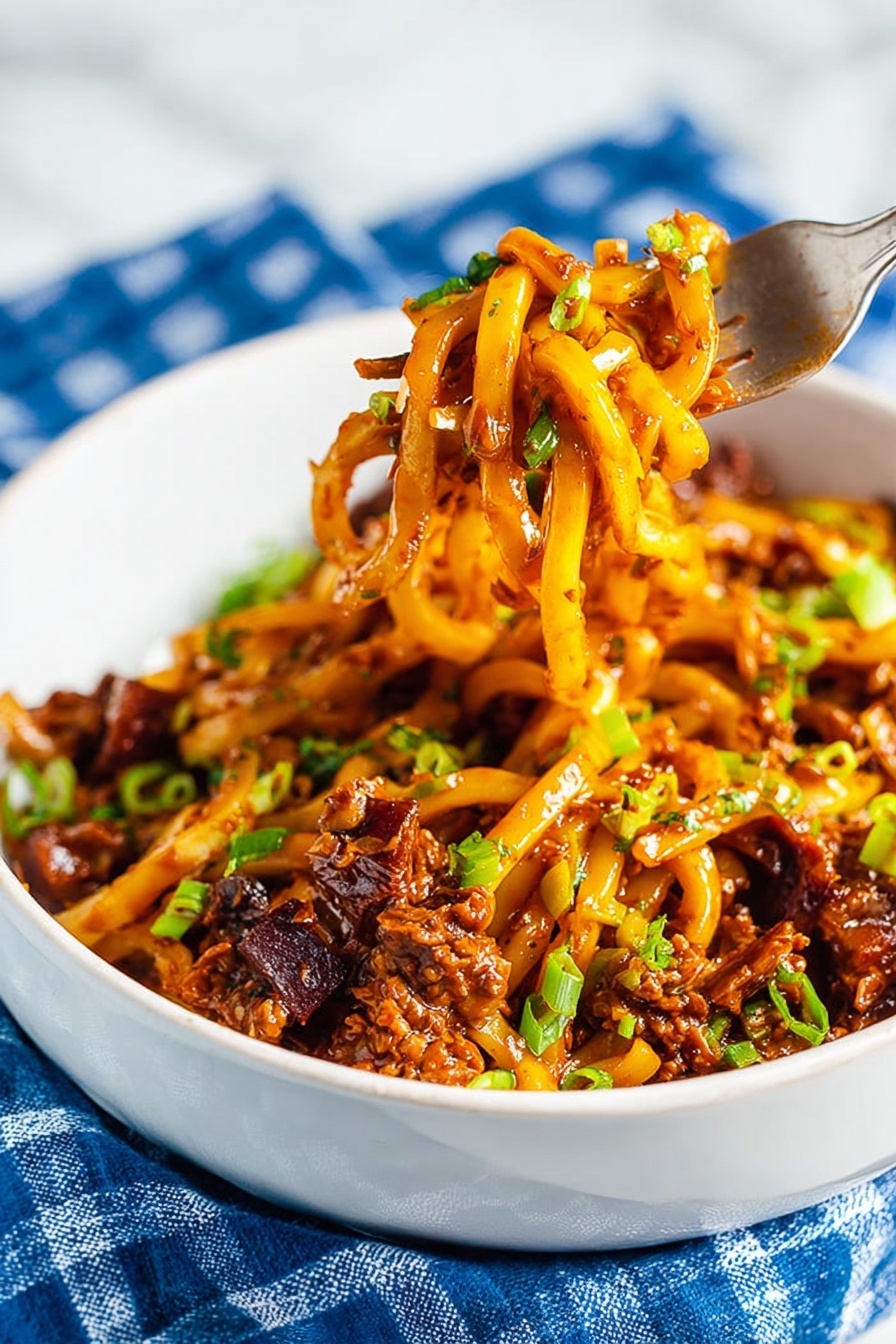
Garnishes
I always go for a sprinkle of fresh coriander and black sesame seeds—simple but they add wonderful color and texture. Sometimes, I add a few thinly sliced scallions or a drizzle of toasted sesame oil at the end just before serving.
Side Dishes
This pairs beautifully with steamed or sautéed greens like bok choy, Korean-style kimchi, or even a crunchy cucumber salad. On busy nights, I keep it simple with a quick side of pickled vegetables or steamed broccoli.
Creative Ways to Present
For special occasions, I like serving this in individual stone bowls or deep ceramic dishes to keep it warm longer, and add a soft-boiled egg on top for extra richness. Garnishing with a few chili threads or finely julienned carrots makes it look stunning on the table.
Make Ahead and Storage
Storing Leftovers
After cooling, I store leftovers in an airtight container in the fridge. The flavors actually deepen overnight, but the noodles may soak up more sauce and soften further, so I usually keep some extra udon on the side to refresh the dish if needed.
Freezing
I freeze the shredded beef and sauce separately without the noodles. When ready to eat, I thaw carefully and add fresh noodles to keep their perfect texture. This way, the dish stays just as delicious as when freshly made.
Reheating
I reheat leftovers gently on the stove over medium heat with a splash of water or stock to loosen the sauce. If noodles seem too soft or absorbed, I often add fresh cooked noodles and toss everything together for the best texture.
Frequently Asked Questions:
Absolutely! While udon is perfect for its chewy texture and ability to hold sauce, you can substitute rice noodles or even ramen for a different twist. Just adjust the cooking time at the end so they don’t overcook.
No worries—ox cheek is traditional because it becomes tender and flavorful when slow cooked, but short ribs, chuck roast, or even oxtail work beautifully. Just make sure to cook long enough for them to become tender.
The recipe has a mild to medium heat level, mostly coming from the gochujang. If you want it spicier, feel free to add extra chili paste or fresh chilies during cooking. If you prefer it milder, reduce the gochujang or balance with a tad more sugar.
You can definitely make this on the stovetop in a heavy pot or Dutch oven by simmering the beef covered on low heat for around 3 hours, until tender. Just keep an eye on the liquid and adjust as needed, then finish by adding the noodles at the end.
Final Thoughts
Honestly, this Slow Cooker Korean Beef Noodles Recipe feels like a warm hug in food form. It’s easy enough to make any day but impressive enough for company. Plus, there’s nothing quite like coming home to a slow cooker full of amazing Korean flavors waiting for you. I hope you enjoy making and sharing it as much as I do!
Print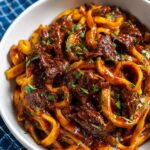
Slow Cooker Korean Beef Noodles Recipe
- Prep Time: 15 minutes
- Cook Time: 8 hours 25 minutes
- Total Time: 8 hours 40 minutes
- Yield: 4 servings
- Category: Main Course
- Method: Slow Cooking
- Cuisine: Korean
Description
This Slow Cooker Korean Beef Noodles recipe combines tender slow-cooked ox cheek with a flavorful Korean-inspired sauce and udon noodles, creating a comforting and savory dish perfect for a satisfying meal.
Ingredients
Sauce and Base
- 1 large onion, finely diced
- 2 tablespoons gochujang
- 2 tablespoons dark soy sauce
- 2 tablespoons rice vinegar
- 1 tablespoon packed light brown sugar
- 1 tablespoon garlic ginger paste
- 1 tablespoon tomato paste
- 3 ½ ounces low-sodium beef stock
Meat
- 14 ounces ox cheek (or substitute with ox tail, short ribs, or chuck roast)
Noodles and Garnish
- 4 pouches ready-to-use udon noodles
- 1 to 2 tablespoons roughly chopped fresh coriander
- 1 tablespoon black sesame seeds, for garnish
- Kosher salt and freshly cracked black pepper, to taste
Instructions
- Prepare the sauce base: Combine finely diced onion, gochujang, dark soy sauce, rice vinegar, light brown sugar, garlic-ginger paste, tomato paste, and low-sodium beef stock in the slow cooker. Stir well to mix all ingredients thoroughly.
- Add and coat the meat: Place the ox cheek on top of the sauce mixture, ensuring to coat all sides with the sauce. Cover the slow cooker with its lid.
- Slow cook the beef: Cook on low heat for 8 hours until the meat is tender and easily shredded.
- Shred the meat: After cooking, remove the ox cheek and shred it using forks or tongs. Return the shredded meat to the slow cooker, mixing it well with the sauce.
- Add noodles and herbs: Add the ready-to-use udon noodles and roughly chopped fresh coriander to the slow cooker. Stir gently to combine.
- Cook noodles: Increase heat to high and cook for an additional 25 minutes to allow the noodles to heat through and absorb flavors.
- Season and garnish: Season the dish with kosher salt and freshly cracked black pepper to taste. Sprinkle black sesame seeds on top before serving.
- Serve: Dish out the Korean beef noodles and enjoy this flavorful, hearty meal.
Notes
- If ox cheek is unavailable, substitute with ox tail, short ribs, or chuck roast for similar results.
- Gochujang can vary in spiciness; adjust quantity to your taste preference.
- Use low-sodium soy sauce and beef stock to control saltiness.
- For more flavor, you can sear the meat before adding it to the slow cooker, though it is optional.
- Fresh coriander adds a bright herbaceous note but can be omitted or replaced with green onions if preferred.
- Black sesame seeds add a nutty crunch and visual appeal but can be skipped.
- Ensure noodles are ready-to-use udon for best texture; if using dried noodles, cook separately before adding.
- The preparation time includes chopping and assembling ingredients; actual hands-on time is minimal.
Nutrition
- Serving Size: 1 serving
- Calories: 450 kcal
- Sugar: 6 g
- Sodium: 700 mg
- Fat: 20 g
- Saturated Fat: 7 g
- Unsaturated Fat: 10 g
- Trans Fat: 0 g
- Carbohydrates: 40 g
- Fiber: 3 g
- Protein: 35 g
- Cholesterol: 80 mg

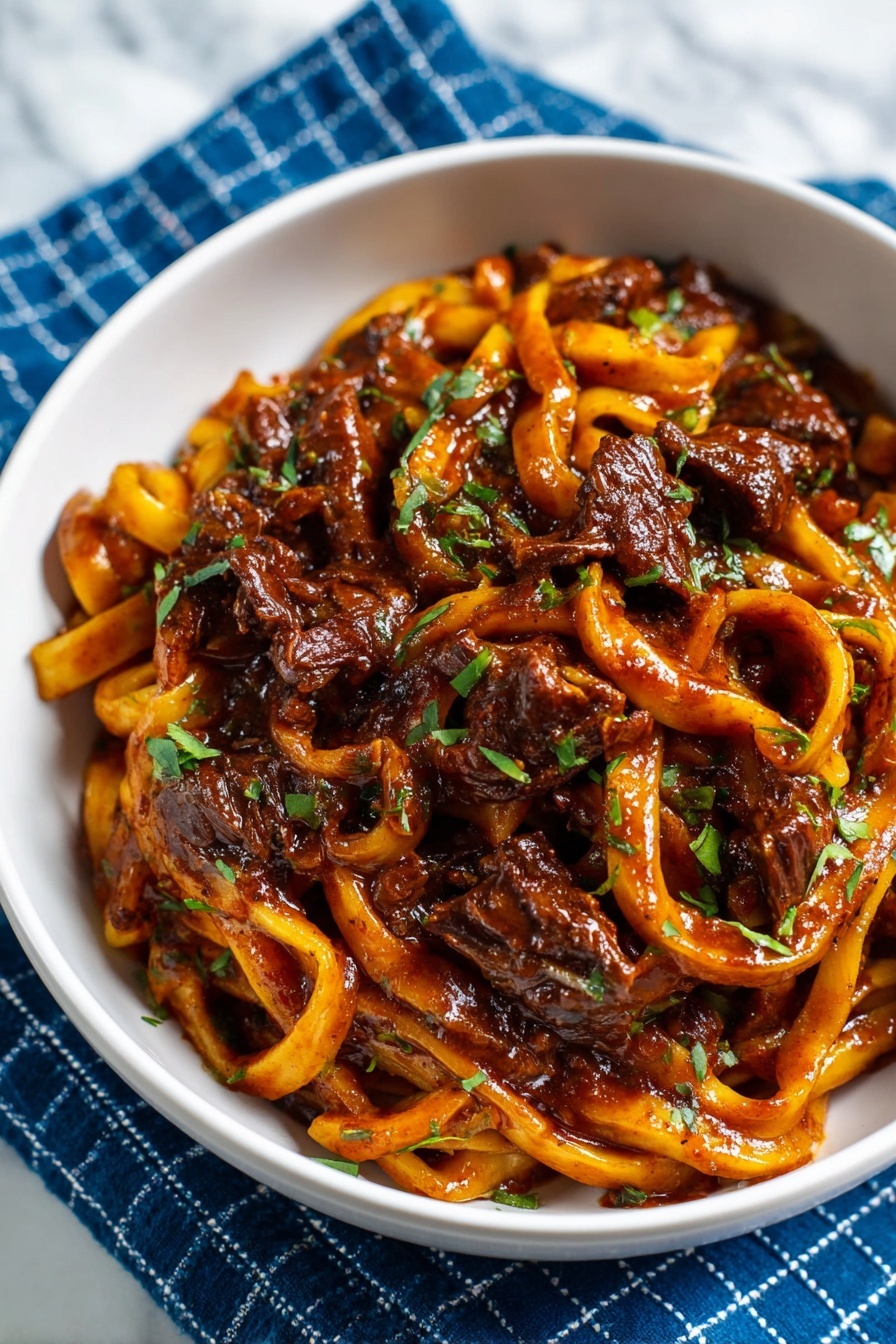




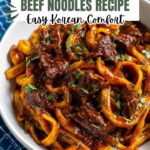
Leave a Reply